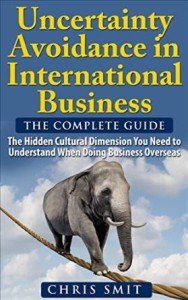The dimension that matters most in Cultural Differences is often claimed to be Power Distance Index or PDI
to be Power Distance Index or PDI
Even up to 80% of all cultural friction is attributed to this Power Distance index! There are 3 more dimensions of culture but let’s first focus on this one since it is so important.
A Definition of Power Distance Index
Let us start with a definition, so we are all on the same page:
“All animals are equal, but some are more equal than others.” George Orwell
Or to put it in a more official way, Power Distance is the: “Level of acceptance of people, who have no power, of the unequal spread of power in their society.“
The interesting aspect of phrasing the Power Distance definition is that it is written from the perspective of people who have no power.
The definition loses all or most of its “value” if you leave that part out. In other words, if one already has the power, it does not matter much if people, who have no power, accept this or not.
Much like having wealth or money: if you have wealth or lots of money, it does not matter much if other people don’t have as much.
Interpretation
There are countries whereby people Do accept that there is power inequality. These countries will score high on Power Distance. Countries, whereby people Do Not accept that there is power inequality, will score low on this power distance index (all on Professor Geert Hofstede’s cultural dimensions).
Nuance
We need to nuance the above interpretation: All cultures/countries in the world have some level of power un-equality. In the low(er) scoring countries, people accept the fact that there are people who have more power in order to avoid a state of chaos or anarchy. In other words, in the low(er) scoring countries people will accept that the police is able and/or allowed to ask them for their ID or pull them over for a traffic violation.
The Differences
Below are the difference between Low and High Power Distance. Two notes in the margin: This list is not complete, below are just a couple of illustrations; Second, there are no cultures that have all of the low characteristics and none of the high characteristics.
When scoring low, they will have more of the low characteristics and fewer of the high characteristics. Culture is not black and white, there are numerous gray shades!
Low Power Distance Culture Examples
Below are some examples of low power distance culture:
- Independence; People are (relatively) independent of the Power Holder (parents, teacher, boss, etc).
- Good reason for hierarchy; When there are, so called, hierarchical layers, there must be a good reason for this. Putting a management layer, or manager in place just like that, will not easily be accepted.
- What goes for you goes for me; Or equality: if you are allowed to do this, then I’m allowed to do the same as well.
- Open door policy; This could literally mean that the door of the manager is open, or that the management of a company is not automatically on the top floor of the building.
Of course is the above list not complete. Nor are there low power distance cultures that have only low power distance culture characteristics and none of high power distance culture.
High Power Distance Culture Examples
And here are some examples of high power distance culture:
- Dependence; People are (relatively) dependant on the Power Holder. This could result in subordinates not taking own initiative, but rather wait for the boss to give instructions. There is also relatively little real empowerment.
- Hierarchy is just there; In other words, it is existential. It’s there, and that’s good and normal.
- Special treatment; Typically there are privileges for the people in power. Like the parking place in front of the office, etc.
- Gate keepers; Gate keepers are those people who keep the power holder away from the people who have no power. Often the Power Holder derives a certain level of status from not being approachable.
The same as with low power distance culture: there are no high power distance culture that have only high power distance culture characeristics and none of low power distance culture.
Examples of low power distance culture are:
- The Netherlands
- The UK & USA
- Germany (yes!)
- Nordic countries
Examples of high power distance culture are:
- Belgium
- France
- Malaysia
- The Arab World
Do you have other examples of low power or high power distance culture? Share them in the comments below!
Get a Taste of How Chris Presents, Watch his TEDx Talk
 Call Direct: +32476524957
Call Direct: +32476524957
 European Office (Paris) Whatsapp: +32476524957
European Office (Paris) Whatsapp: +32476524957
The Americas (USA; Atlanta, GA; también en Español): +1 678 301 8369
Book Chris Smit as a Speaker
If you're looking for an Engaging, Exciting, and Interactive speaker on the subject of Intercultural Management & Awareness you came to the right place.
Chris has spoken at hundreds of events and to thousands of people on the subject of Cultural Diversity & Cultural Competence.
This is What Others Say About Chris:
- “Very Interactive and Engaging”
- “In little time he knew how to get the audience inspired and connected to his story”
- “His ability to make large groups of participants quickly and adequately aware of the huge impact of cultural differences is excellent”
- “Chris is a dedicated and inspirational professional”
In addition, his presentations can cover specific topics cultural topics, or generally on Cultural differences.
Presentations can vary anywhere from 20 minutes to 2 hours and are given worldwide.
Book Chris now by simply sending an email. Click here to do so.
Read more about what Chris can do for you.
- Percentage of People Rating a Presentation as Excellent 86%
- Rating the Presentation as Practical 89%
- Applicability of Chris' presentation 90%
About Peter van der Lende

Peter has joined forces with Culture Matters.
Because he has years and years of international business development experience joining forces therefore only seemed logical.
Being born and raised in the Netherlands, he has lived in more than 9 countries of which most were in Latin America.
He currently lives in Atlanta, Georgia (USA) with his family.
You can find out more at https://expand360.com/
Or find out what Peter can do for you here.
- 192 Cultural Differences and Franchising with Adam Goldman - 11 June 2025
- 191 Coffee Culture with Martin Mayorga - 3 April 2025
- 190 Collectivism in Western Culture with Rob Lion - 19 March 2025

 to be Power Distance Index or PDI
to be Power Distance Index or PDI Call Direct: +32476524957
Call Direct: +32476524957 European Office (Paris) Whatsapp: +32476524957
European Office (Paris) Whatsapp: +32476524957


I can’t understand why the UK and USA have low scores on PDI. The UK and USA are very much dependency cultures and very elitist – meaning managers and workers are different and our place in society is defined for us (by other people) and it is our job to stand there and “be fixed” by someone in authority or who has power over us. UK and USA culture both fit the High PDI characteristics. Please explain.
Hi Ryan,
Thank you for your comment.
I would think you’re either from the UK or US yourself. If that’s the case, than you would be the fish in your own bowl. Meaning that it is usually difficult to describe your own culture, and easier to describe an other culture, not being your own.
I think what you’re confusing here are Power Distance and Masculinity (or Process versus Goal orientation).
Workers in both countries are dependant on money if anything, not on their boss.
They might do what their boss tells them, but only between 9-5. After that their boss is just another person, and not someone “higher”, or “more”.
Let me know what you think.
Hello Chris,
Thank you for your response. I am sorry for the large gap between our responses. Anyway, after reading your response, I still don’t follow this. What makes this confusing is that it’s not just an outright or categorical “this country has low power distance, therefore this is the behaviour we’d expect to observe from people in that society.” So for example, low power distance means there is not much inequality between managers and workers. But that is not actually the case in UK culture and I’m pretty sure it isn’t in America because it has a free market economy and division of labour where managers have privileges and subordinates don’t.
There are other factors at play here it seems. So what I’m trying to say is that just because a country has a low or high power distance does not necessarily mean we’d expect people in that society to behave as such, as there are other factors at work.
Am I correct in saying that it is because the US and UK are masculine societies is the reason for the inequalities between people in society i.e. we accept that society is hierarchical rather than flat like it is in the Scandinavian countries?
So it is culture here that dictates behaviour (of people) rather than power distance?
Hello Chris again,
I’ve just realised that the reason it seems Scotland or the UK/US (whatever) have lower power distance cultures but it does not seem that way is because of government policy. Am I right?
Hi Ryan,
Here’s my reply to your questions/confusion:
Re-read my first comment about being the fish in your own bowl. The implication of that is, is that it’s more difficult for you to describe your own culture than someone else’s culture.
Second point is that you talk about Power distance being high. As opposed to what? Remember that there are no absolutes in culture. There is no culture either high or low. One is only higher or lower than another.
Ask yourself this: is the hierarchy stronger in the UK than in China or India? If your answer is “No” then you’re looking at lower power distance in the UK/US versus China.
Only with that comparison, you’re talking useful about cultural differences.
Third, government policy does not dictate culture. It’s the other way around. Culture comes first. Out of that comes the rest. E.g. Economic policy, legal, educational, government.
Would you agree that the US & UK are democracies? Where you can vote for whom you want? Is this the same in Thailand? or Indonesia?
Finally, the separation between management and workers in the US/UK is something that can be “bridged”. In other words, you can grow from worker to manager. Work hard, do your best, put in the extra hours (something like that).
In France, if you’ve gone to school at one of the “Grande Ecole’s” you’re bound to get a high management position.
If you’re still confused, drop me an email and we’ll setup a Skype call to talk. That’s a lot easier than typing back and forth 😉
Hi Chris,
I was hoping you could direct me to some resources on the subject of power distance and learning to successfully communicate across cultures. I see your referrals above, but they seem to be for low power index cultures/individuals learning to communicate with high power index cultures/individuals. I was born and raised in the US, but am a 2nd generation Korean. So I am interested in learning to break my tendencies within my high power index culture upbringing and being able to communicate to low index cultures.
Thank you!
Rebecca
Hi Rebecca,
Thank you for your comment.
Your question is clear, the answer is a lot more complicated. I would have to know what you mean with “break my tendencies”. The devil is in the details. Also here.
Second thing is that the difference between Korea and the US is not only in Hierarchy. But also the second dimension: Loyalty. In general, Koreans are loyal to the group they belong to (e.g. family), while Americans have a much stronger Loyalty to Self.
So a possible “pull from your parents or Korean family is not only related to Hierarchy, but also to Loyalty.
Hope this helps.
Could you please bring examples of High Power Distance and Low Power Distance in TV commercials?
Hi Meline,
Thanks for your comment.
I’ve done some searching on the Internet but couldn’t find the commercials that I have on my drive here.
I guess they’re taken off of YouTube
There’s a commercial of a bank called MeesPierson with Walter Matthau out there. But couldn’t find it online anymore.
Also, I have a commercial of “A life in pictures of George W. Bush” in it you see a growing up G. W. Bush in pictures (obviously) but in every picture, you see the presence of Jesus…
Keep searching, and if you find something, please let me know.
Hi Chris! Can you compare me Russian and American values?
Hi Aikosha,
Sure I can:
Russia: 90 (not the highest, that’s Malaysia)
USA: 39
In this case, there’s a big difference; more than 10 points, so that’s certainly significant.
Hope this helps.
Hello, Can you give me a real-world example of why Malaysia is having such a high PDI?
Hi Irias,
Maybe this will help: “This extreme division of power traces back to a joint legacy of the Malay feudal system and the influence of the British. As a result, Malay culture is very respectful of a complex, nuanced system of titled classes and untitled “commoners,” and tends to grant much power to those at the top of an organization.”
Kind regards,
Chris
Hey chris,
would you rather rate Cameroon with a high PDI or a low PDI. why I am asking is because it is one of the countries not mentioned by Hofstede model of power distance.
Thanks,
Kind regards.
You can safely say that Cameroon will have a “high” score on Hierarchy. However, it all depends on the context. Possibly compared to Malysia, it is not as high but compared to the UK it can be. You can only talk meaningfully about cultural differences by the grace of comparison.
Hope this helps.